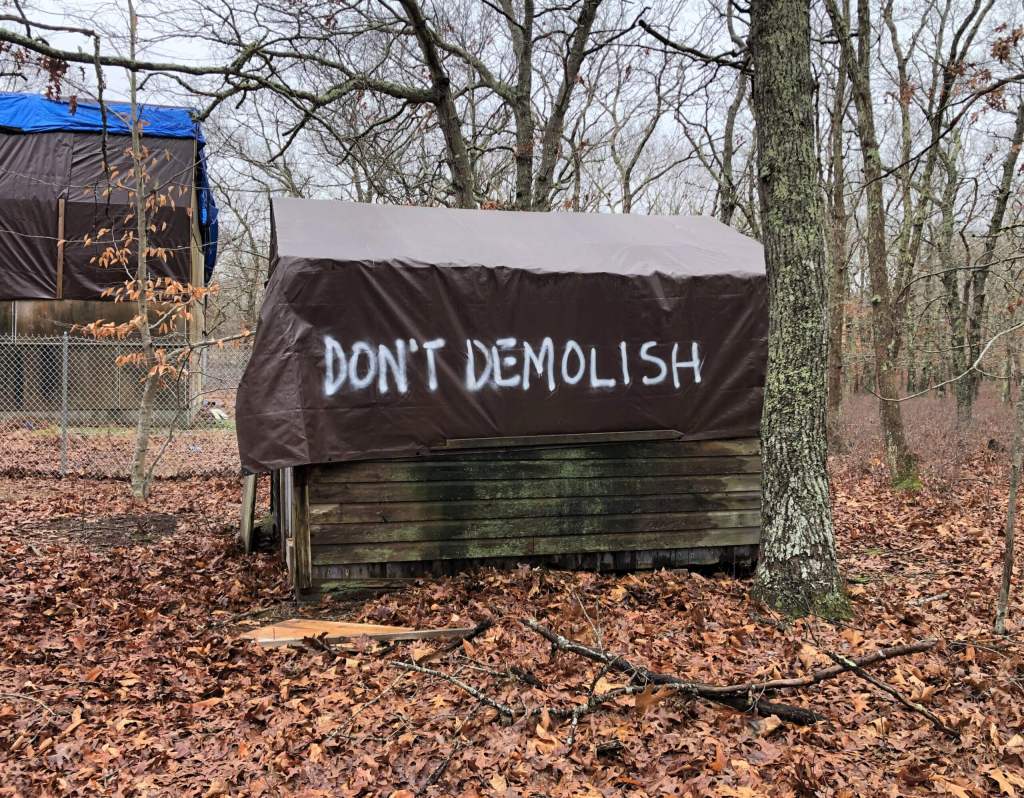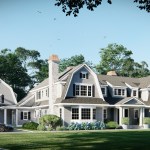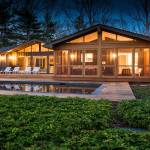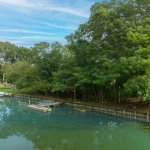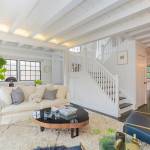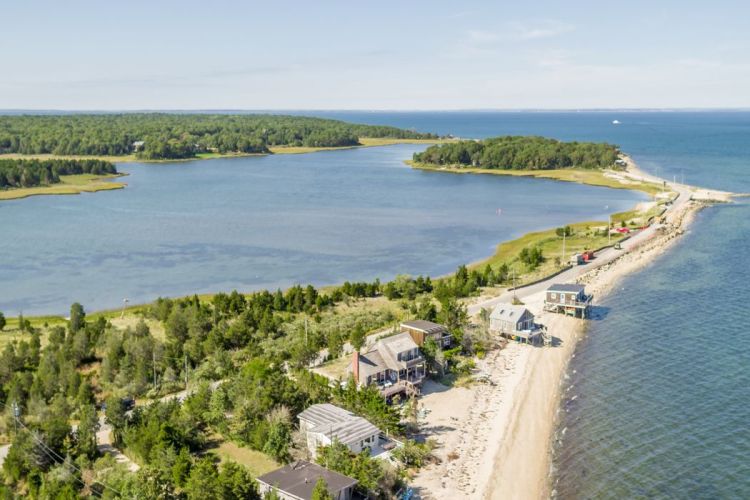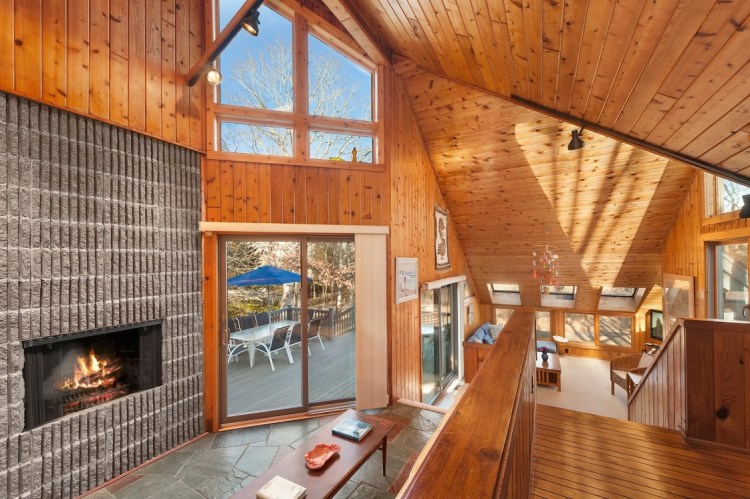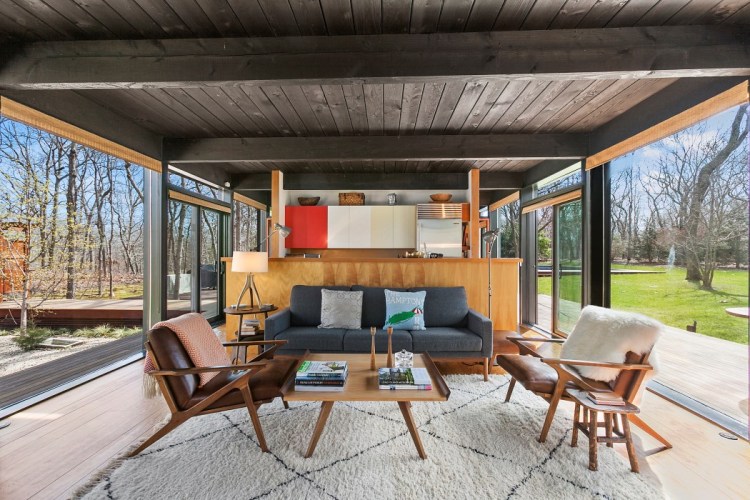The message to the East Hampton Town Board was clear after a conditions report on the former home, studios and guest house of Abstract Expressionist artists James Brooks and Charlotte Park: Much can and should be saved.
The Springs property, owned by the town, has had historic designation for nearly 10 years, but little progress has been made in restoring or maintaining the four buildings, seen as important time capsules for the artistic movement. As they continued to deteriorate and have been subjected to vandalism over the years, questions on whether the town should invest what has grown to now an estimated $3 million have arisen.
“As a preservationist, please save these buildings,” Michael Devonshire, an architectural conservator with 40 years of experience in historic preservation, told the town board on Tuesday, March 21. His firm, Jan Hird Pokorny Associates (JHPA), which has also worked on the Nathaniel Rogers House in Bridgehampton, prepared a building conditions report, offering information on what interventions would be necessary to retain historic materials and keep the buildings as historically authentic as possible.
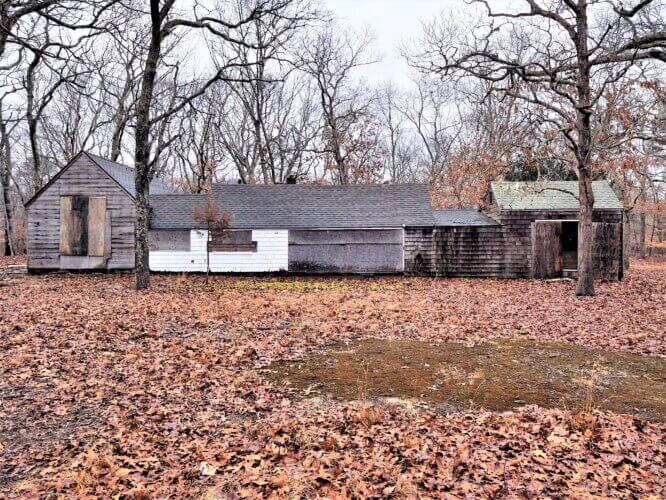
“It is our opinion that the rich cultural importance of the Brooks-Park association with the site renders it deserving a restorative approach, emphasizing a period of interpretation of the 1970s–1990s in order to retain as much as possible of the artifactual remains of the buildings in which these two immensely gifted artists performed their acts of creation,” he said in the report.
Devonshire says the proposed Brooks-Park Arts and Nature Center could easily be a case study for deferred maintenance and lack of care.
The Town of East Hampton bought the 11-acre property for $1.1 million in 2013, using money from the Community Preservation Fund, created with revenues from a 2% tax on most real estate transactions. While demolition of the structures was initially discussed, residents pleaded to save them, and they were designated local landmarks in 2014, which allowed CPF money to be used toward the restoration of the property.
But, the property seems to have been in limbo ever since.
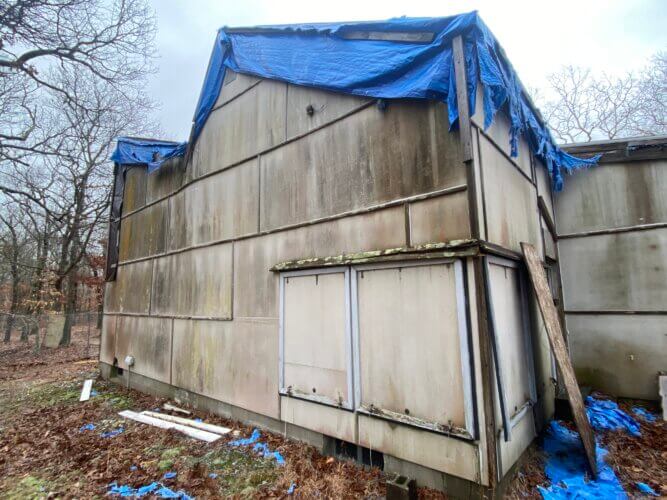
Last year, it gained some overdue attention when Preservation Long Island got involved, followed by the black-eye designation of being one of the 11 most endangered historic places in America, according to a 2022 list from the National Trust of Historic Preservation.
Brooks and Park were significant artists, “not stars the way Pollock was,” Devonshire said, but they were part of the early Abstract Expressionists. Brooks was one of “The Irascibles,” the name given to the now famed artists like Willem de Kooning, Jackson Pollock and Robert Motherwell.
Park was “generally overshadowed by her male partner,” as was often the case for the time, Devonshire pointed out, but she did experience some impressive accolades later in life.
Brooks died in 1992 and Park lived in their home on Neck Path until her death in 2010.

A Painter’s Smock and Where Pollock Slept
JHPA’s investigation, based on a site assessment in January, revealed “what appear to be an amalgam of pre-existing structures moved to the site, the best efforts of a competently (but not overly so) skilled ‘builder,’ and the results of skilled tradespersons; while some of the construction is well executed, other examples of untrained efforts are evident.”
There are four structures: the Brooks-Park residence, the James Brooks studio, the Charlotte Park studio and the guest cottage.
The main residence, originally a small cottage moved from Montauk to the site in 1957, has been expanded at least three times with different esthetic styles. “The seemingly arbitrary collection of additions to the original structure reflect in a way the organic and non-orderly or esthetically confined nature of the owners,” the report stated.
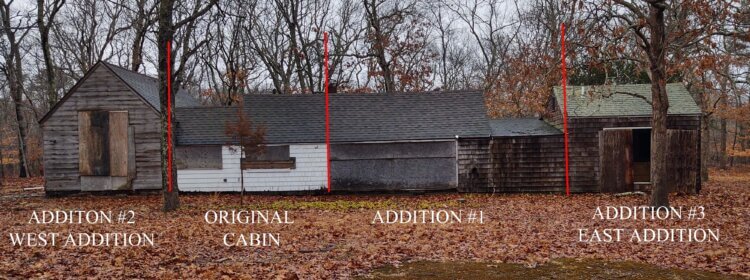
Despite damage from deteriorated roofing, broken doors and windows from vandals, “the residence is in remarkably good condition structurally,” said Kurt Hirschberg, an architectural designer with JHPA who also spoke at the meeting.
Nevertheless, there are no signs of “exterior conditions that cannot be addressed and cured with appropriate intervention,” the report states.
The interiors are in a similar state, although vandalized and deteriorated, they can be fixed. Mechanical and electrical systems, however, are too far gone and would need to be replaced for public use of the building.

Brooks’ studio is the most imposing, and problematic of the four buildings, Devonshire explained. Once restored, it is a large enough space for public assembly, he added.
The original structure, believed to have been built in the 1960s, features an industrial “sawtooth” roof configuration with north-facing clerestory windows – perfect for an artist’s studio, the report points out. A one-story addition was used to store materials and finished works, has partially collapsed and is beyond salvage, but there are elements that can be established in a new structure.
There is a complicated roof assembly, using metal flashings and without proper maintenance led to roof leakage and serious interior damage in the main body of the studio and presents the greatest safety hazard on the site.
The exterior wall cladding sheets of Transite, a contemporary fireproofing, contain asbestos, which requires remediation.
“It is possible to restore the Brooks studio – an effort that will be costly,” the report says. “However, in this studio, the essence of the genius of Brooks is still palpable – his paint materials are still extant. Elements of the studio, the walls, façade windows, et cetera, can be salvaged, restored and reused. The walls can be restored. The roof and clerestory elements must be carefully removed and replicated. The one-story storage wing is partially collapsed and beyond restoration. Some elements of this structure (ex: windows, aluminum siding) can be salvaged for reuse on a new structure.”

As for Park’s studio, a cottage relocated to the site in the 1970s, it is perhaps the most compelling of the four structures, Hirschberg said. “Although there’s been some vandalism, it’s not hard to imagine that she’s only temporarily left the studio.”
Her painter’s smock still hangs on the north door (It has since been removed).
The studio sits on no more of a foundation than a shed would have, he said. The structure could be lifted and set atop a new foundation. The roof sheathing and skylight assembly needs replacement. Due to the lack of complexity of the building, remedial work would be fairly simple.
Even the small space heater in the studio could be rehabilitated for interpretive use. The report recommends the building serve as a “view only” resource.

Lastly, the guest cottage: “The least architecturally impressive on the site,” Devonshire said, “nevertheless with no less cultural significance than the other buildings.”
It was used by several important artistic figures, friends of Brooks and Park, including Pollock, though he lived not far away, but was known to tie one on.
“Not too difficult to image Jackson Pollock sleeping off a bender in this cabin,” Devonshire joked.
Supervisor Peter Van Scoyoc added, “We could put a plaque out that says: ‘Pollock passed out here.’” The guest cottage requires simply lifting it to perform foundation repairs and making exterior and interior repairs.
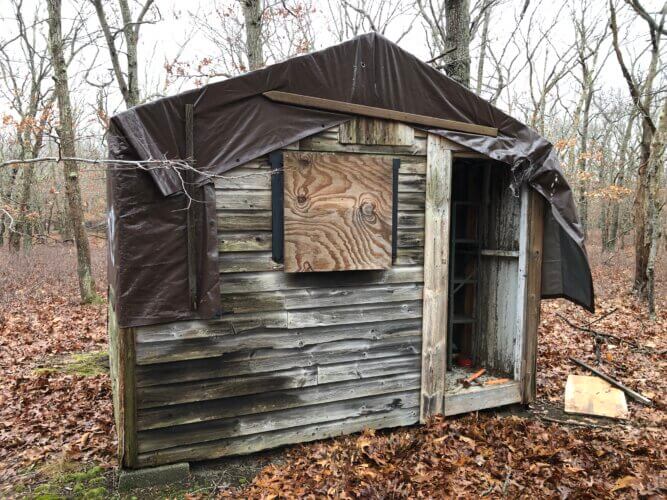
Next Steps
Van Scoyoc said the conditions report was an important first step in deciding what to do next.
Changes to how money from the Community Preservation Fund can be used has been a “game changer,” referring to a determination that now allows individuals to live in historic structures as docents.
Devonshire agreed and said a portion of the residence could be sectored off for a site security docent. The supervisor said the board needs a strategy on what to deal with first and overall ideas on how the property will be managed going forward.
Devonshire said the project could be a phased approach with high-priority items taken care of first, such as the Brooks studio, while Park’s studio and the guest cottage “could be mothballed and put off until later.”
“I think the town is committed to this project,” Councilwoman Sylvia Overby said. She quoted Mike Solomon, whose father was the artist Syd Solomon: “There are three things that are uniquely American: Jazz, baseball and Abstract Expressionist. We are at the forefront in East Hampton … It is a privilege to be there and we should embrace it.”
Councilman David Lys pointed out that he would like any artifacts on the site stored immediately so they can be used in retrospect later (They have since been removed).
“I would fear that this conversation would lead to more vandalism and more eyes on it,” he said. A six-foot chain link fence had already been erected around the studio.
“I’m hoping now there’s enough momentum,” Van Scoyoc said, adding that he hopes the groups gathering around the project “will help guide us forward to help make this property a beacon for this Abstract Expressionist movement, which is unique to us in East Hampton, Springs particularly.”

Community Watching
“We learned from the cave drawings in Spain that, for 40,000 years, art has been representational,” said Marietta Gavaris of the Brooks-Park Art & Neighborhood Center Committee, who was the first to speak during the town board’s public portion session, before the assessment report was presented.
“Then in the 1940s and 1950s, a group of artists gathered right here in Springs and started what we now know as Abstract Expressionism and in so doing created a whole new form of communication,” she continued.
“Just as you would not destroy the caves in El Castillo, Spain, you should not demolish what John Mullen called the ‘cathedral of Abstract Expressionism,’”she said speaking of the founder of the Brooks-Park preservation effort.
“The preservation story of this important site has gone national, and history will carefully record those among us who have either hindered or helped preserve this culturally important site for future generations. Please make your intentions clear and schedule a funding vote soon. History awaits your decision,” Gavaris concluded.

“Their property is a treasure, and it should not be allowed to fall into disrepair and just go away,” said Helen Harrison, the director of the Pollock-Krasner House and Study Center in Springs, who called into the board meeting. She was the first person to present the historical survey that caused the town board to give the property historic designation back in 2014.
“I know that the budget has increased pretty significantly in the past nine years since it was designated a town landmark,” but she said she hoped the board would still move forward.
Irwin Levy, a 34-year resident of Springs who co-hosts a podcast called “Our Hamptons,” also phoned in to implore the board to make the right decision.
“I feel like I’m living in a moment where the current town code is allowing a seismic shift that is visually jarring. We are seeing enormous spec houses shoehorned, to quote the architectural critic Paul Goldberger, into completely small lots on Amagansett’s Handy Lane, changing it forever.
Iconic Ditch Plains in Montauk has a house that’s meer size seems to loom ominously over the parking lot,” he said, adding that “massive houses of 12,000 to 14,000 square feet are obliterating rural vistas and viewsheds” along streets like Wainscott Hollow Road and many others.
“Is East Hampton a place to extract from or give back to? Are we a community or a commodity?” he asked. While the price to restore the building has no doubt increased in recent years, Levy said it is “a heavy lift” the town could afford. He rattled off a slew of historic and important properties saved from the Gardiner homestead to the Moran House in East Hampton to the Arts Center at Duck Creek in Springs.
“And the Atlantic Double Dunes – 8.5 Bluff Road acres purchased by your town board predecessors in 1982 for $300,000. I’ll bet anything that was a heavy lift in that day as well,” he said.
“You’re at a crossroads here and Brooks-Park is a metaphor for it. We either embrace or celebrate and preserve our history and our rich sense of place, or we don’t. I ask most respectfully please save Brooks-Park.”
Email tvecsey@danspapers.com with further comments, questions, or tips. Follow Behind The Hedges on Twitter, Instagram and Facebook.

